Best Oil for Seasoning Cast Iron Pan: 23 Oils Reviewed
Seasoning cast iron for some reason puts fear into most people when, in fact, it is a simple task. Choosing the correct oil to season the iron with is another hurdle those new to cast-iron cooking also have to overcome. So what is the best oil for seasoning cast iron?
The best oil for seasoning cast iron is grapeseed oil, followed by flaxseed oil, vegetable oils, and canola oil, as well as seasoning oils and conditioners produced by cast iron manufacturers themselves. Cast iron seasoning oil has to have high smoking points to achieve polymerization.
A high smoke point is what is required for polymerization, which is the process of oil being baked onto a cast iron’s surface. This is a natural process providing a non-stick surface that also prevents iron rusting.

Disclaimer: I earn from qualifying purchases on my website as an Amazon Associate. If you purchase through links from this website, I may get a small share of the sale from Amazon and other similar affiliate programs.
What Is Seasoning Oil?
Cast iron seasoning oil is a product that you can use to season your cast-iron pans. To name a few oils: olive oil, grapeseed, flaxseed, soybean, corn oil, vegetable shortening, and lard.
Seasoning creates an invisible, protective layer of polymerized fat on the surface so it won’t stick or rust as easily when exposed to water and other substances.
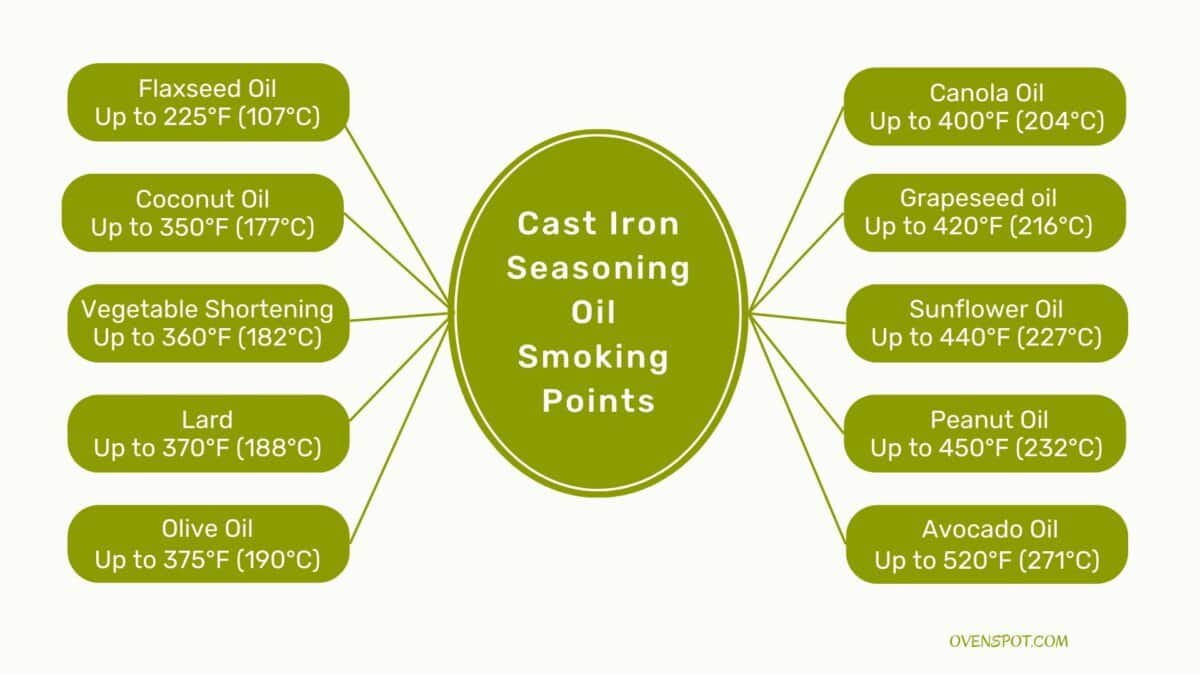
Why is Seasoning Cast Iron Cookware Important
Cast iron needs to be seasoned in order to create a non-stick surface. The seasoning is a layer of oil that is baked onto the cast iron. This layer of oil protects the cast iron from rusting and helps to create a non-stick surface.
The layer of oil also creates a smooth surface. Cast iron has very small pits and crevices that need to be filled before it can become non-stick. The seasoning fills in these pits, thus creating a smoother cooking surface.
It is important to understand that any food cooked in cast iron will also pick up some of the flavors from the seasoned pan. Foods that are high in acids, such as tomatoes or wine, may cause some of the seasoning to wear off.
What Is the Best Oil for Seasoning a Cast-Iron Pan

This table outlines the properties of the 11 best seasoning oils for your cast-iron pan, including the smoke point of the oil and its fat content. Number 1 is the best option all the way down to the ones that will do the job but not give you a sustainable seasoned finish.
| Best | Oil | Saturated Fat | Poly-Unsaturated Fat | Mono-Unsaturated Fat | Smoke Point | Oven Temperature |
|---|---|---|---|---|---|---|
| 1 | Grapeseed | 10.5% | 74.7% | 14.3% | 421 °F | 441 °F |
| 2 | Flaxseed | 9.0% | 68.0% | 18.0% | 225 °F | 245°F |
| 3 | Corn | 12.9% | 54.7% | 27.6% | 450 °F | 420 °F |
| 4 | Canola | 7.4% | 28.1% | 63.3% | 460 °F | 480 °F |
| 5 | Vegetable | 14.0% | 33.0% | 48.0% | 450 °F | 470 °F |
| 6 | Avocado | 11.6% | 13.5% | 70.6% | 482 °F | 502 °F |
| 7 | Olive | 13.8% | 10.3% | 73.0% | 380 °F | 400 °F |
| 8 | Vegetable Shortening | 25.0% | 28.0% | 41.0% | 410 °F | 430 °F |
| 9 | Bacon Grease | 32.0% | 11.0% | 41.0% | 394 °F | 394 °F |
| 10 | Lard | 39.0% | 11.0% | 45.0% | 374 °F | 394 °F |
| 11 | Coconut | 87.0% | 1.8% | 6.0% | 400 °F | 420 °F |
1. Grapeseed Oil
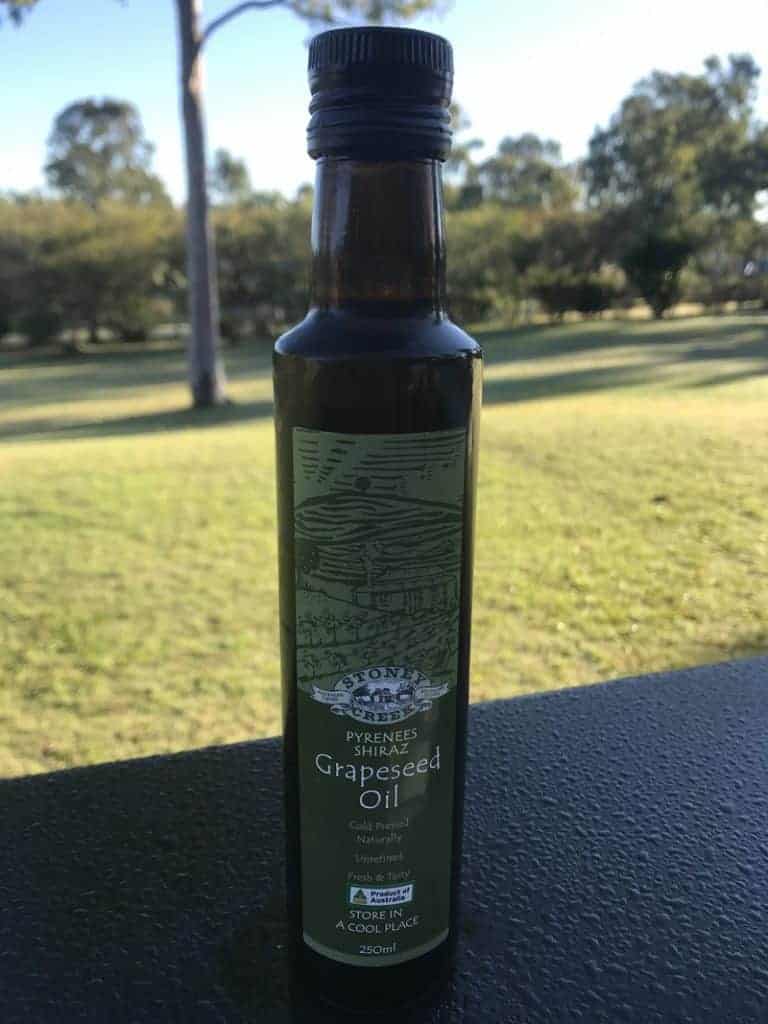
The best cast iron seasoning oil is grapeseed oil. It is expensive but I have found that grapeseed oil is becoming more readily available and the price is coming down. I have found a good choice in a 3-liter bottle available at Amazon for a great price – check that out here.
Why is grapeseed oil good for seasoning cast iron? Refined Grapeseed Oil can withstand high heat has a high smoking point at 480 degrees Fahrenheit or 250 degrees Celsius and is extremely resistant to breaking down.
But you should be very wary of the words “cold-pressed” and “virgin” as these have been designed for not only cooking but to be used as “gourmet” in dressing, desserts, and the like. As they have a low smoke point.
2. Flaxseed Oil
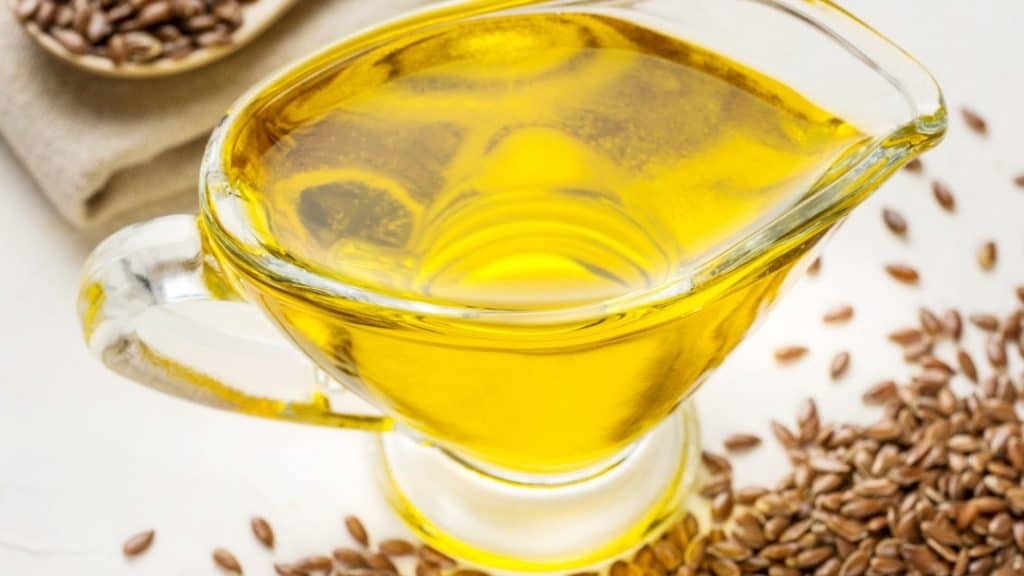
Flaxseed oil is another oil that is highly recommended for seasoning. If you use nut or vegetable oils they need to be pure and refined.
Flaxseed oils’ smoking point is 225 degrees Fahrenheit or 107 degrees Celsius which is not very high. It should be noted that unused oil will go rancid if not used quite quickly.
Flax oil is a drying oil that makes it perfect for seasoning cast iron pans. It’s comprised of 68% polyunsaturated fats and 86% unsaturated fats, making this the best choice in oils to season your pan with.
3. Corn (Maize)

Refined corn oil can be heated as high as 450 degrees Fahrenheit or 235 degrees Celsius.
Cold-pressed “virgin” and “unrefined” 320 degrees Fahrenheit or 160 degrees Celsius, this oil will not do the job of seasoning cast iron.
4. Canola Oil (Rapeseed Oil)
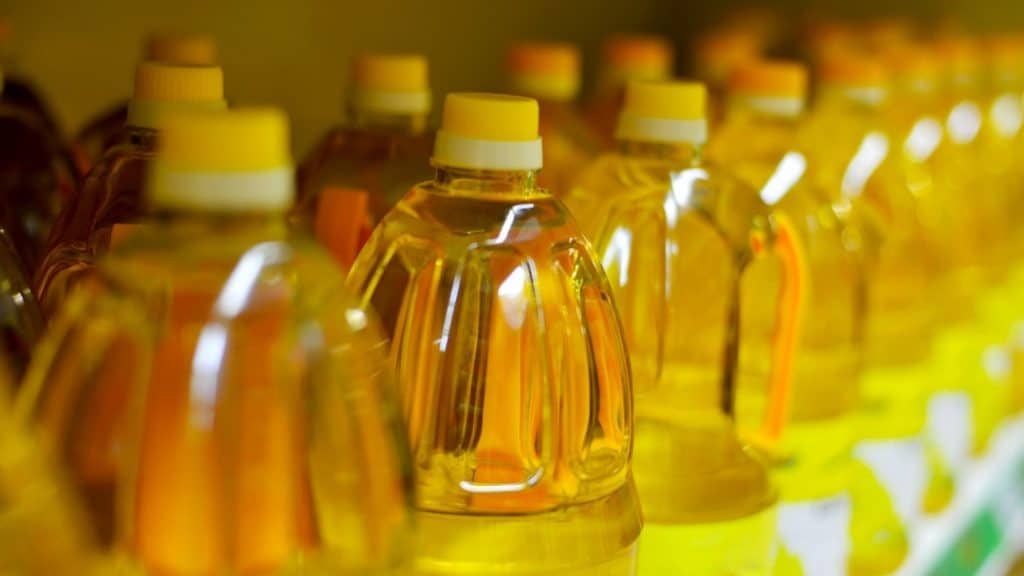
This oil is an excellent seasoning for when your cast iron is to be stored for long periods of time. A resin finish can be achieved which protects the cast iron while in storage. You should also be prepared for a pungent odor in the kitchen after seasoning with this oil.
Heat cast iron in the oven at approximately 250 degrees for 2 hours. Then wipe a light coating over the iron, and cook for 45 minutes to 1 hour. Apply and cook at least one more time.
When the iron has cooled wipe it over to remove any excess before storage.
Rapeseed Oil can be heated as high as 400 degrees Fahrenheit or 200 degrees Celsius.
Cold-pressed “virgin” and “unrefined” 225 degrees Fahrenheit or 110 degrees Celsius.
5. Vegetable Oil
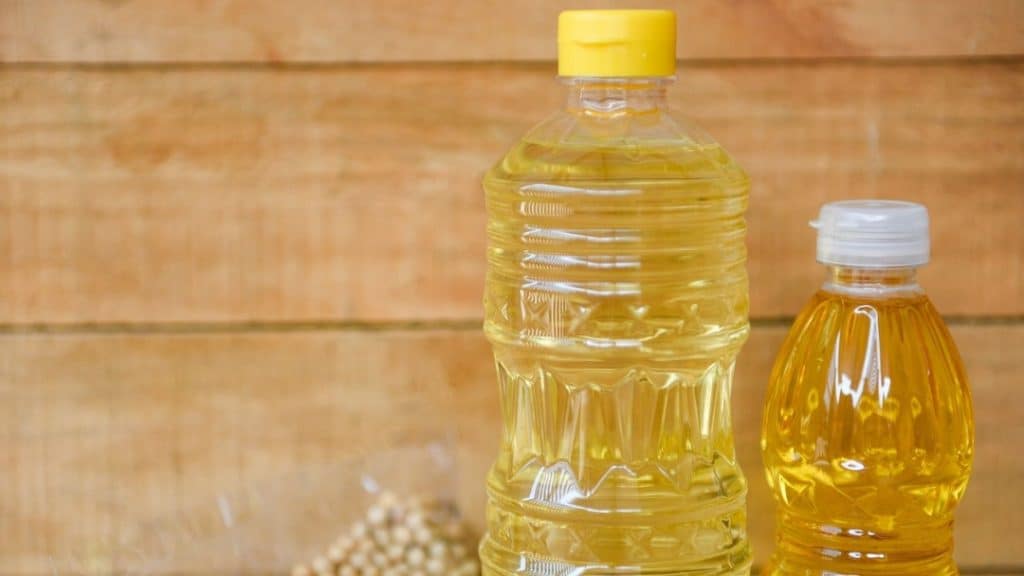
Vegetable oil covers many varieties of oil including the ones listed below. Although many recommend vegetable oil for seasoning these oils are heavily refined with nasty additives.
6. Avocado Oil
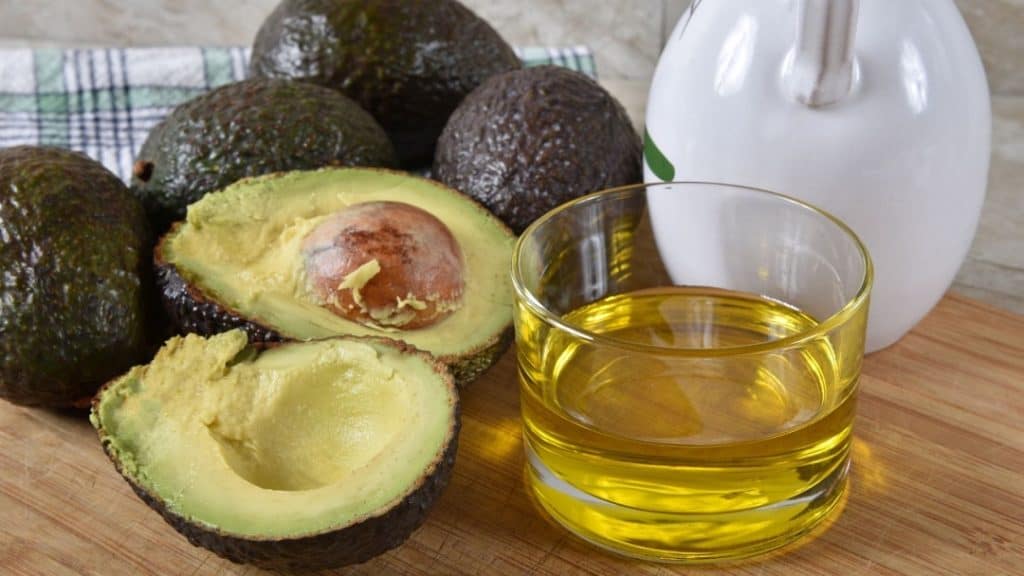
I have recently been testing out avocado oil. I have been using it for my high-temperature searing and stir-fries. So, I thought I would give it a go.
I will revise this post when I am 100% certain I would recommend this oil for seasoning.
One amazing find is that – after cooking in avocado oil is that there is always oil left in the bottom of the pan. Almost all other oils dissipate “just like water”. I pour the leftover oil over the prepared dish it tastes divine.
REVISED 2024: I have been testing seasoning and cooking in organic avocado oil due to its high smoking point and its ability to fight rancid properties. While I am still using lashings of oil for cooking and particularly frying in my cast iron I am currently seasoning my cast iron with high-quality Grapeseed Oil.
7. Olive Oil

Pure Olive oils’ smoking point is 410 degrees Fahrenheit or 215 degrees Celsius.
Cold-pressed “virgin” and “unrefined” 320 degrees Fahrenheit or 160 degrees Celsius.
Is olive oil good for seasoning cast iron? I would not choose olive oil due to its low smoking point. Basically, you cannot the oil into the pores of the cast iron because it burns off too early.
It is a great choice of oil to cook with once your cast iron is seasoned correctly. It will help keep your irons “Patina” in good shape.
See my article, which dives deep into the olive oil and cast-iron combination.
8. Vegetable Shortening (Crisco)

It is a genetically modified oil, and lard is increasingly being used in favor of the manmade variety.
Vegetable Shortening‘s smoking point is 410 degrees Fahrenheit or 230 degrees Celsius.
9. Bacon Grease

This grease has a smoking point of 360 degrees Fahrenheit or 185 degrees Celsius.
You apply bacon grease by rubbing a fatty piece of bacon over the cast iron.
When applying the bacon to the iron you will find it difficult to get the grease into the surface areas. So you will not be able to fully season the iron.
Arguments are out there that the salt in the bacon grease will pit the iron.
10. Pig Fat (Lard)
Lard has a smoking point of 360 degrees Fahrenheit or 185 degrees Celsius.
Lard soaks into the pores of the iron when applied warm and liberally.
It also works wonders if you have to repair a rusty piece of cast iron cookware.
11. Coconut Oil

Refined (pure) oil can be heated as high as 450 degrees Fahrenheit or 232 degrees Celsius.
Is coconut oil good for seasoning cast iron? Even though coconut oil has an extremely low oxidation factor, it is highly durable as a frying oil, even more durable than beef tallow.
Virgin oil has to be kept below 350°F/175°C, so you should be very wary again of what you are purchasing.
12. Safflower Oil
Refined safflower oil can be heated as high as 510 degrees Fahrenheit or 265 degrees Celsius.
Cold-pressed “virgin” and “unrefined” 225 degrees Fahrenheit or 110 degrees Celsius.
13. Sesame Oil
Refined sesame can be heated as high as 450 degrees Fahrenheit or 210 degrees Celsius.
Cold-pressed “virgin” and “unrefined” 320 degrees Fahrenheit or 160 degrees Celsius.
14. Soybean Oil
Refined and high oleic soybeans’ smoking point is 450 degrees Fahrenheit or 235 degrees Celsius.
The cold-pressed “virgin” and “unrefined” smoking point is 320 degrees Fahrenheit or 160 degrees Celsius.
15. Sunflower Oil
Refined and high oleic sunflower oils’ smoking point is 450 degrees Fahrenheit or 235 degrees Celsius.
“Virgin” or “cold-pressed” sunflower oils have a very low smoke point and should not be for seasoning cast iron. Sunflower oil will go rancid quicker than olive oil or canola oil.
Cold-pressed “virgin” and “unrefined” 225 degrees Fahrenheit or 110 degrees Celsius.

Other Iron Seasoning Oils
Regardless of what oils are recommended for seasoning cast iron successfully, many use various oils, including vegetable oils, animal fat oils, dairy oils, manmade seasoning, and minerals oils.
Vegetable Oils
16. Peanut Oil
The smoking point is 450 degrees Fahrenheit or 235 degrees Celsius.
The Chinese use peanut oil to reach high temperatures when searing and stir-frying and it retains its flavor when used in this fashion.
Cold-pressed “virgin” and “unrefined” 320 degrees Fahrenheit or 160 degrees Celsius.
17. Almond Oil
Refined – the smoking point is 495 degrees Fahrenheit or 255 degrees Celsius. This oil can give your cast iron a durable finish.
But you are likely only to be able to find “unrefined” oil which as with some of the other nut oils cannot be heated to high temperatures.
18. Walnut Oil
The refined version of walnut oil has a smoking point of 400 degrees Fahrenheit or 204 degrees Celsius, which I don’t believe is high enough to season cast iron. But you could give it a go if you can get your hands on pure, refined walnut oil.
The common walnut oil you will find is unrefined and can be used for frying at low temperatures, but usually, it is used for salad dressings.
Cold-pressed “virgin” and “unrefined” 320 degrees Fahrenheit or 160 degrees Celsius.
Vegetable Oils – The Verdict
The following oils will go rancid very quickly when heated at high temperatures. This is mainly because these oils are not generally available as refined products.
They are high in polyunsaturates because they have been manufactured to become “Virgin” Or “Cold Pressed”. They are suitable to use at low temperatures or in salad dressings and the like.
The Oils Are:
Sunflower, Olive, Soybean, Canola, Safflower, Sesame, Peanut, and Walnut.
Some believe that because vegetable oils are much more liquefied than animal fats these oils get into the pores of the cast iron.
Due to the fact that the pure versions of these oils are not readily available, I would stay away from them. Unless you can get a hold of pure oil.
Many have used Crisco in the past but due to genetic modifications, they have turned to more natural and untouched oils. Coconut oil for seasoning cast iron is my first choice if using vegetable or nut oils.
I would suggest that if you want to use vegetable oil and can source a pure oil that can withstand high temperatures go ahead and season your cast iron with it.
The next best vegetable oil would probably be Canola.
Animal Fats
19. Duck and Goose Fat
Unfortunately, as flavorsome as these lovely fats are, they only have a very moderate smoking point, which is 375 degrees Fahrenheit or 190 degrees Celsius.
Continue to use these for your awesome potatoes but not for seasoning your cast iron.
20. Bear Fat and Deer Fat
If you are happy to eat bear and deer meat, why not utilize the fat as well? Rub the fat over the Dutch oven and season as you normally would any other oil.
Animal Fats – The Verdict
As our ancestors did not have access to genetically modified food sources, I believe they only used animal fats in their cast iron.
This cookware still exists in various forms and is being used today by many worldwide.
Bear in mind that it may not be kosher! So if you are preparing food for others, something to consider.
Dairy Fat
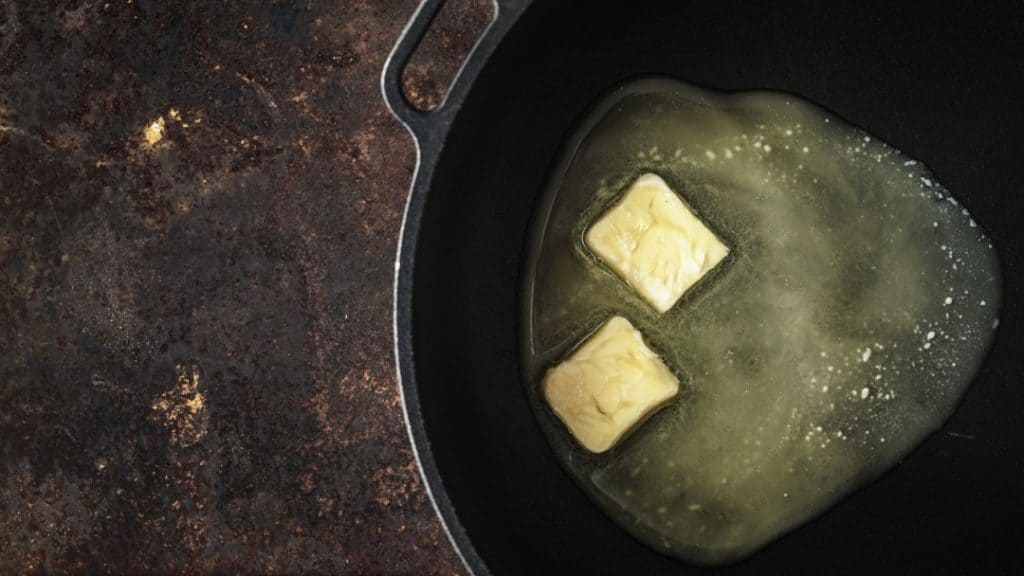
21. Butter
Butter should only be used over very low heat. Whole butter has saturated fats, milk protein, and oils from the cream during the churning process.
Unfortunately, when the butter gets too hot, it turns brown and burns quickly. You would be left with a very bitter-tasting seasoning.
Just think of all the recipes that require butter for its moist browning properties.
So, that rules this seasoning out as it cannot tolerate the high temperatures required to season cast iron.
If you have had an accident and need help cleaning up your Dutch oven, check out this article on how to clean a Dutch oven after cooking.
22. Mineral Oil
It is great for making wood utensils and cutting boards water-resistant. It should not be used to season cast iron.
If a regular seasoning process is carried out, it can stop a significant cleaning and seasoning process from being required.
23. Purpose-Made Cast Iron Seasoning
Suppose you want to get the job done and not figure it out for yourself. Click the image below to head to Amazon for Caron & Doucet Cast Iron Seasoning Oil and Conditioner. It is a popular choice from 100% plant-based refined coconut oil.
Why Is a Seasoning Oils Smoking Point Important?
To keep your cast iron cookware well protected, the oil must reach its smoking point before it can polymerize and form a protective barrier. For this process to occur, you’ll need to know the smoking point of an oil so that heating your pan will be as effective.
Understanding Cooking Oils
Any oils modified to become Light, Virgin, or Unrefined have a much lower smoking point. Unfortunately, these oils are generally available to us and are not the pure version of the oil. These modified oils are the ones that quickly become rancid.
You now have an understanding of the different properties of oils as well as what is required to ensure your cast iron seasoning reaches its “Patina” (its smooth, shiny non-stick surface). Check out the oils below to help you choose the seasoning oil that is right for you.
Cold Pressed Oil
Pressed oils are created using a mechanical press to extract the oil from seeds. The end product of this process is high-quality plant fat made up of no cholesterol that has been protected against oxidation, so it lasts longer on the shelf without having any rancid taste.
Unrefined & Refined Oils
The oils we use in cooking and seasoning are separated into unrefined and refined. Crude oil is lightly filtered to filter out only the largest particles, while refined ones go through a much more complex process of filtering that removes even microscopic pieces from the oil.
Saturated Fats & Unsaturated Fats
Common saturated fats include lard, suet, tallow from cows, and sheep’s fat.
Unsaturated fat is a lipid usually liquid at room temperature, such as vegetable oil-based spreads like margarine.
When cooking with oils, it is best to use unsaturated fats. They are more reactive and polymerize better when seasoning your dish! The same applies when seasoning or protecting your cast iron. Unsaturated fats are better at polymerizing when seasoning than saturated fats.
Monounsaturated Fats
Monounsaturated fats have one double bond, which makes them more stable than polyunsaturated and saturated fats.
Polyunsaturated Fats
A higher percentage of double bonds (up to 6) polyunsaturated fats creates a better, longer-lasting protective coating for cast iron.
Signs That Your Cast Iron Cookware Needs Seasoning
If you have food sticking to your cast iron, it means that the seasoning has broken down. There is not enough of a barrier to stop the food from adhering to the pores of the iron.
Which then, in turn, burns the food into the pores and makes a sticky mess.
This is when an arduous cleaning process is required and a complete reseasoning process is followed.
How to Season Cast Iron
The cast iron must be cleaned and thoroughly dried before any seasoning is applied to its surface.
You can then use a paper towel to apply a thin layer of the oil of your choice over the surface of the iron. Make sure to apply it to the underside, lid, and handles.
Ensure your oven has a tray or aluminum foil placed under where the iron will be set in the oven. Invert the cast iron and lid on a middle oven rack at 450°F.
Bake the iron for approximately one hour.
Let it cool in the oven, and repeat if necessary.

Grease Keepers
Who remembers back in the day when your grandmother used a grease keeper? My grandmother had no spare change to purchase fats or oils.
So, she kept all cooking oils and fats in her grease keeper.
I do remember as I got older, she started to buy lard. This was only when she was no longer cooking for the whole family, so she didn’t have a good supply of drippings.
The one I use is similar to the one below – mine is an heirloom piece made from ceramic.
Money-Saving – Recycle Cooking Oil
Using a grease keeper will save you money if you save and reuse your grease from cooking.
FAQs
These are quick answers to some of the many frequently asked questions about seasoning cast iron and the oils and processes involved.
What is seasoning oil?
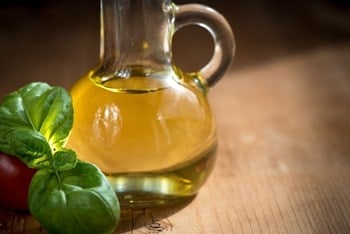
Seasoning oil is an oil used to protect cast iron from rusting. It is also used to season cast iron as a non-stick barrier, which is built up over time so the cast iron effectively becomes a non-stick pan.
What kind of oil do you use to season a cast iron skillet?
Regardless of the type of cast iron you want to season, you can use the same oil that you would use for your cast-iron skillet.
You can use a refined pure oil such as the Grapeseed Oil outlined above. Alternatively, choose a purpose-made cast-iron seasoning like the cast-iron oil pictured below.
Should you season cast iron after every use?
No, you do not need to season cast iron after every use. Season your cast iron before its first use. Then reseason it when your dishes stick to the bottom of the pot, pan, or skillet. Or when you notice the Patina is becoming dull.
I am also frequently asked how many times I should season my cast iron. There is no limit to seasoning cast iron. It is just a season when it becomes dull, and food starts to stick to it.
How many times do you season a cast iron skillet?
Generally, three to four times during the seasoning process. The caveat is how well the non-stick “Patina” (surface) is intact. Suppose your food is sticking. Repeat the process until you see a shiny black surface. If your food is released once or twice, you should do it.
How to clean a rusty cast iron Dutch oven
Before any seasoning can be applied to cast iron, it must be clean and dry. So, if you have a rusty Dutch oven, check out my article. It will give you the quick steps you need to get the cast iron ready for seasoning.
Final Thoughts: What Is the Best Oil for Seasoning Cast Iron?
What is the best oil to season cast iron? The best oils for seasoning are grapeseed and flaxseed.
There are another couple of great points that have emerged:-
- People who use their cast iron regularly have better-seasoned iron because the oils from the dishes they prepare season the cast iron themselves.
- Save money by saving your “drippings,” as I remember them being called.
When shopping for iron seasoning oils for my raw cast iron oil, smoke point is the most important factor.
I’m all for the least touched by man. I’m for full-fat, fresh produce, hearty food purchases, preparation, and cooking. Taught to me by my relatives.
My grandparents lived to 94 and 93 (mum’s side) and 89 and 90 (dad’s side).
Don’t get me wrong, they, too, fell prey to the low-fat no fat craze until they got hungry.
“My favorite oil for cooking is organic avocado oil due to its high smoking point and ability to fight rancid properties. Another interesting fact about cooking in avocado oil is that oil is always left at the bottom of the pan when your food is fried. I then use this oil and pour it over my cooked dish. It tastes divine”.
“Remember, I am currently using a high-quality Grapeseed Oil to season my cast-iron cookware.
Also, remember these words should be stated on any bottle: “organic,” “extra virgin,” “unrefined,” and “cold-pressed.” This is the one I use here.
If it is good enough to cook and eat them, it is good enough to season our cast iron.
Cast iron has been around for many centuries. Our forefathers would not have had easy access to vegetable oils, nut oils, and the like. I dare say that they would not have even seasoned their cast iron cookware. Their cookware would have seasoned itself purely by cooking meat with cast iron daily. Beautifully seasoned cookware the natural way.
I would love to thank Clove Garden for its extensive research into all things oil. You can visit them here for a wealth of information regarding oils and much more.
Are you looking for a new cast iron Dutch oven and want to research more? Check out these cast-iron Dutch ovens that I have reviewed in-depth.
Recommended Read
Learning how to season a cast-iron Dutch oven is simple. This article I wrote makes the process simple and quick to care for an iron skillet.
One-Pot Cooking Rocks!

Michelle
Hi, I’m Michelle, the founder, owner, author, and editor of OvenSpot. My passion for one-pot cooking commenced when I was working to prepare cafeteria lunches for school students. I am now on a mission to assist you in choosing the cooking pot or appliance you will use daily. As well as in-depth information to assist you in using and caring for your cookware and appliances.
Questions? Reach out to Michelle at [email protected]


